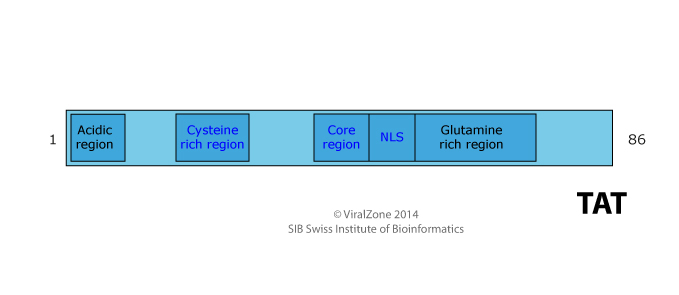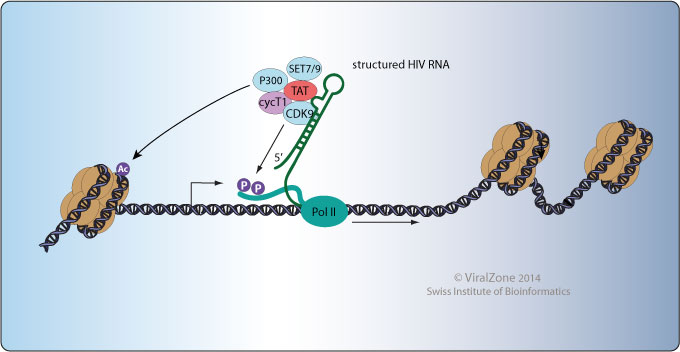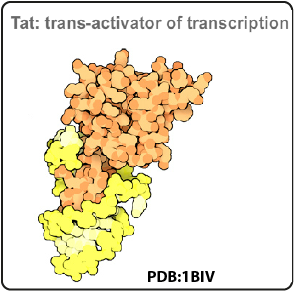HIV-1 TAT protein


| Host protein | Modification | Residue(s) | Proposed effect | Reference | |
| PRMT6 | Arginine methylation | R52 | Reduced interaction with the TAR region of viral RNA |  Arginine methylation of the human immunodeficiency virus type 1 Tat protein by PRMT6 negatively affects Tat Interactions with both cyclin T1 and the Tat transactivation region Baode Xie, C?dric F. Invernizzi, St?phane Richard, Mark A. Wainberg J. Virol. April 2007; 81: 4226?4234 | |
| PRMT7 | Arginine methylation | R53 | Reduced interaction with the TAR region of viral RNA |  Arginine methylation of the human immunodeficiency virus type 1 Tat protein by PRMT6 negatively affects Tat Interactions with both cyclin T1 and the Tat transactivation region Baode Xie, C?dric F. Invernizzi, St?phane Richard, Mark A. Wainberg J. Virol. April 2007; 81: 4226?4234 | |
| PCAF | Lysine acetylation | K28 | Reduced TAT activity to promote microtubule assembly |  Tat acetylation regulates its actions on microtubule dynamics and apoptosis in T lymphocytes Lihong Huo, Dengwen Li, Lei Sun, Min Liu, Xingjuan Shi, Xiaoou Sun, Jingyu Li, Bin Dong, Xin Dong, Jun Zhou J. Pathol. January 2011; 223: 28?36 | |
| P300/CBP | Lysine acetylation | K50 | Reduced TAT ability to bind the TAR RNA element |  Acetylation of HIV-1 Tat by CBP/P300 increases transcription of integrated HIV-1 genome and enhances binding to core histones L. Deng, C. de la Fuente, P. Fu, L. Wang, R. Donnelly, J. D. Wade, P. Lambert, H. Li, C. G. Lee, F. Kashanchi Virology November 25, 2000; 277: 278?295 | |
| MDM2 | Lysine ubiquitination | K71 | Increased TAT transcriptional activity |  A non-proteolytic role for ubiquitin in Tat-mediated transactivation of the HIV-1 promoter Vanessa Br?s, Rosemary E. Kiernan, Laetitia K. Linares, Christine Chable-Bessia, Olga Plechakova, C?line Tr?and, Stephane Emiliani, Jean-Marie Peloponese, Kuan-Teh Jeang, Olivier Coux, Martin Scheffner, Monsef Benkirane Nat. Cell Biol. August 2003; 5: 754?761 | |
| CDK2 | Serine phosphorylation | S16 | Increased TAT transcriptional activity |  Phosphorylation of HIV-1 Tat by CDK2 in HIV-1 transcription Tatyana Ammosova, Reem Berro, Marina Jerebtsova, Angela Jackson, Sharroya Charles, Zachary Klase, William Southerland, Victor R. Gordeuk, Fatah Kashanchi, Sergei Nekhai Retrovirology 2006; 3: 78 | |
| CDK2 | Serine phosphorylation | S46 | Increased TAT transcriptional activity |  Phosphorylation of HIV-1 Tat by CDK2 in HIV-1 transcription Tatyana Ammosova, Reem Berro, Marina Jerebtsova, Angela Jackson, Sharroya Charles, Zachary Klase, William Southerland, Victor R. Gordeuk, Fatah Kashanchi, Sergei Nekhai Retrovirology 2006; 3: 78 |
Life of psi: how full-length HIV-1 RNAs become packaged genomes in the viral particles
Malika Kuzembayeva, Kari Dilley, Luca Sardo, Wei-Shau Hu
Virology April 2014; 454-455: 362?370
Malika Kuzembayeva, Kari Dilley, Luca Sardo, Wei-Shau Hu
Virology April 2014; 454-455: 362?370

